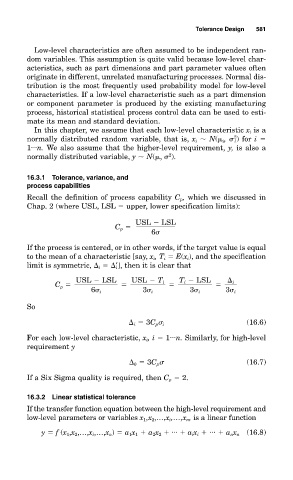Page 628 - Design for Six Sigma a Roadmap for Product Development
P. 628
Tolerance Design 581
Low-level characteristics are often assumed to be independent ran-
dom variables. This assumption is quite valid because low-level char-
acteristics, such as part dimensions and part parameter values often
originate in different, unrelated manufacturing processes. Normal dis-
tribution is the most frequently used probability model for low-level
characteristics. If a low-level characteristic such as a part dimension
or component parameter is produced by the existing manufacturing
process, historical statistical process control data can be used to esti-
mate its mean and standard deviation.
In this chapter, we assume that each low-level characteristic x i is a
2
normally distributed random variable, that is, x i N( i , i ) for i
...
1 n. We also assume that the higher-level requirement, y, is also a
2
normally distributed variable, y N( , ).
16.3.1 Tolerance, variance, and
process capabilities
Recall the definition of process capability C p , which we discussed in
Chap. 2 (where USL, LSL upper, lower specification limits):
USL LSL
C p
6
If the process is centered, or in other words, if the target value is equal
to the mean of a characteristic [say, x i , T i E(x i ), and the specification
limit is symmetric, i ′ i ], then it is clear that
USL LSL USL T i T i LSL i
C
p
6 i 3 i 3 i 3 i
So
(16.6)
i 3C p i
...
For each low-level characteristic, x i , i 1 n. Similarly, for high-level
requirement y
0 3C p (16.7)
If a Six Sigma quality is required, then C p 2.
16.3.2 Linear statistical tolerance
If the transfer function equation between the high-level requirement and
low-level parameters or variables x 1 ,x 2 ,…,x i ,…,x n , is a linear function
y f (x 1 ,x 2 ,…,x i ,…,x n ) a 1 x 1 a 2 x 2 ... a i x i ... a n x n (16.8)

